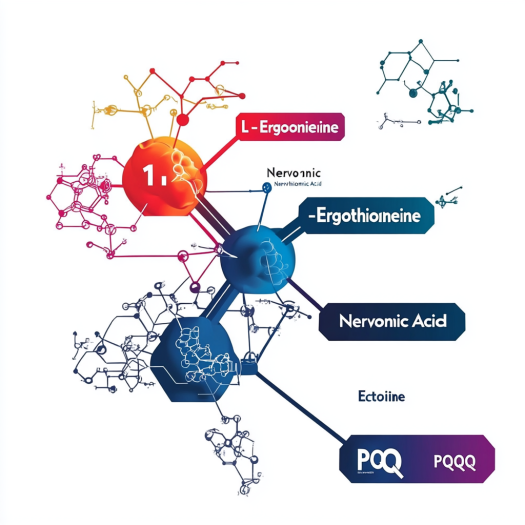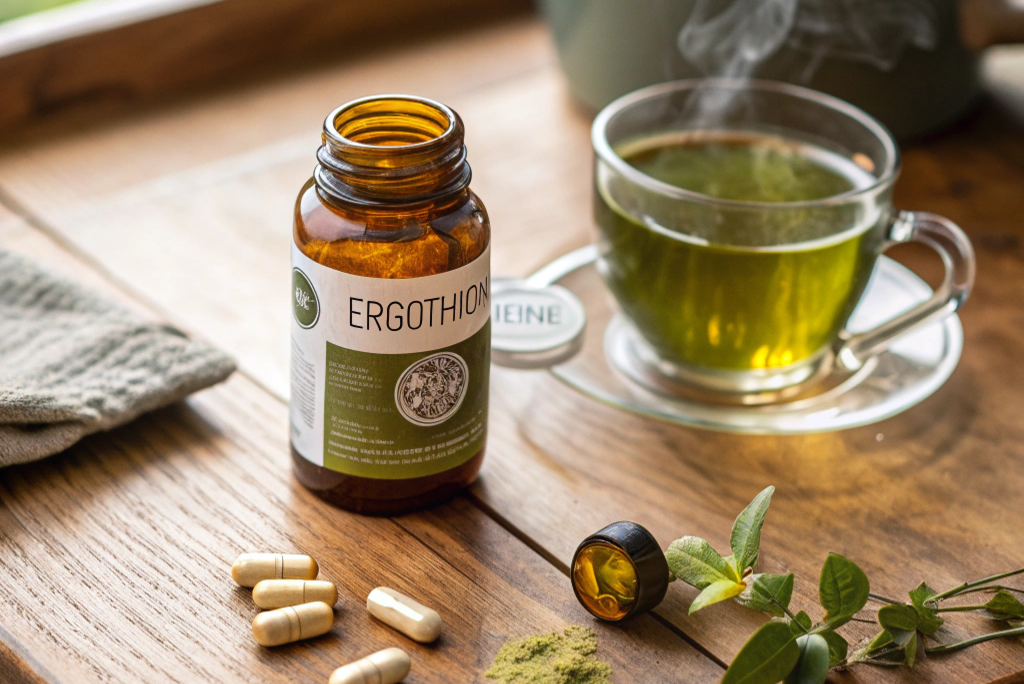
I’ve spent years tinkering with supplements, and ergothioneine keeps popping up as the quiet hero in my daily stack.
Most adults thrive on 5–30 mg of ergothioneine per day, split with meals; research shows this range supports antioxidant defenses, mitochondrial efficiency, and skin resilience without approaching known safety limits.
That headline number sounds tidy, yet dosage isn’t one-size-fits-all—it bends with diet, age, and lifestyle.
How Much Ergothioneine Does the Body Actually Use Daily?
I like to start with the simple question behind every pill—how much do we naturally burn through in 24 hours?
Your body recycles around 1–2 mg of ergothioneine each day but benefits from 5–30 mg because intestinal absorption is limited and modern diets lack rich sources.
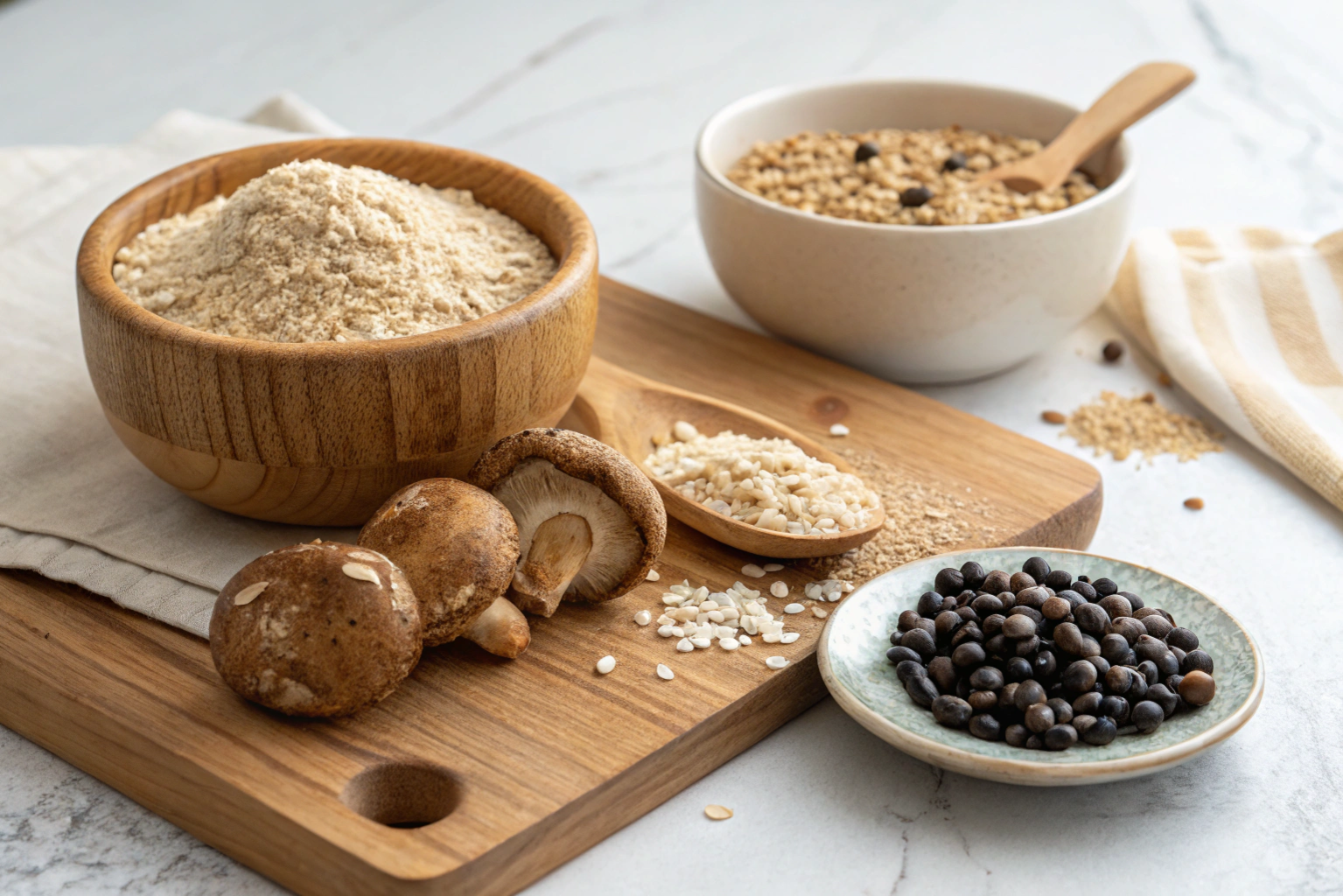
Ergothioneine huddles inside mushrooms, black beans, and oat bran, yet even a generous plate rarely tops 2 mg.
That’s partly why I started supplementing. Scientists have traced plasma levels in mushroom-loving cultures1 and compared them with supplement users. The latter group consistently shows higher intracellular stores and lower markers of oxidative stress.
The Daily Demand Curve
Our cells don’t consume ergothioneine like vitamin C; they sequester it. ETT transporters ferry the molecule into tissues—especially the liver, brain, and skin—where it lingers for weeks, acting as a first-responder antioxidant.
- Basal turnover: ~0.3 µmol ⋅ kg⁻¹ ⋅ day⁻¹
- Stress turnover: spikes 2–3× during intense exercise or UV exposure
- Pregnancy & aging: transporter expression rises, hinting at higher demand
| Life Stage | Typical Intake Gap (mg/day) |
|---|---|
| Young adult | 3–5 |
| Athlete | 8–12 |
| 50 + years | 10–20 |
| Pregnancy | 12–18 |
Given those gaps, my daily sweet spot lands at 15 mg when work is calm, and 25 mg during deadlines or marathon training. Your mileage may vary, yet the underlying math points in a similar direction for most readers.
What Factors Influence the Optimal Ergothioneine Dosage?
Dosing isn’t just math; it’s a story of lifestyle, diet, and genetics that shapes how much your cells beg for.
Exercise intensity, baseline diet, gut health, and even sun exposure all nudge the ideal ergothioneine window up or down.
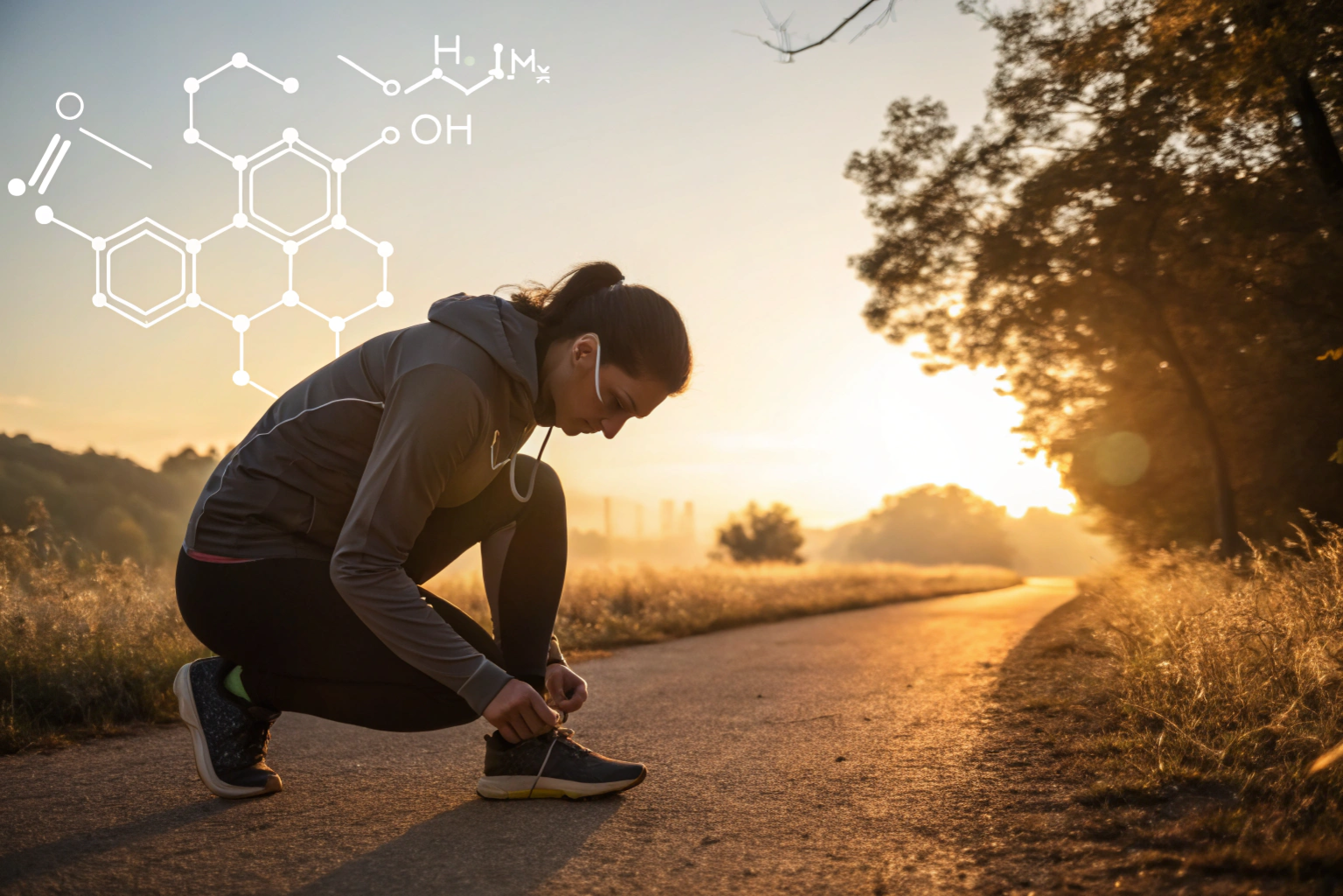
When I swapped office life for weekend trail runs, I noticed more muscle soreness and slower recovery—a sign my antioxidant shield needed upgrading. Doubling ergothioneine from 10 mg to 20 mg trimmed aches and shortened downtime.
Dialing in the Dose
- Diet check:
- If you eat mushrooms daily, you’re already earning ~2 mg.
- Stress thermometer:
- High work stress? Night shifts? Consider +5 mg.
- Exercise load:
- Endurance athletes metabolize more reactive oxygen species; +5–10 mg helps.
- Skin & sun:
- Living at high UV latitude adds 3–5 mg to my personal tally.
For clients formulating capsules, I recommend a 10 mg base with clear guidance to double on heavy-stress days. If you want a ready-to-use raw material that meets US GRAS criteria and EU compliance, my team keeps a third-party-tested ingredient here: Ergothioneine Raw Material. Feel free to peek.
Is There a Safe Upper Limit for Ergothioneine Intake?
Safety should never be an afterthought, and I grilled toxicology papers before taking my first capsule.
Human trials report no adverse effects up to 150 mg/day for 12 weeks, and animal studies show a 1 000 mg/kg safety margin—meaning typical supplements sit far below risk thresholds.
Regulators echo this comfort zone. The US FDA’s GRAS notice cites no observed adverse effect levels (NOAEL) above standard servings, while EFSA green-lit use in food at modest concentrations.
Crossing the Line—Or Not
- 150 mg/day: highest human dose tested, no liver or kidney flags
- Safety factor: >50× when compared with common 10 mg products
- Synergy watch: Pairing with NAC, resveratrol, or vitamin C shows complementary antioxidant profiles without stacking toxicity
I still advise starting low, listening to your body, and bumping gradually—just as you’d ease into weight training.
How Do Different Delivery Forms Affect Absorption?
Capsules, powders, liposomes—each promises better uptake, but the truth sits in the data.
Standard capsules deliver ~35 % bioavailability, while liposomal or Cyclodextrin-complexed forms climb toward 60 %, letting you halve the dose for the same blood levels.
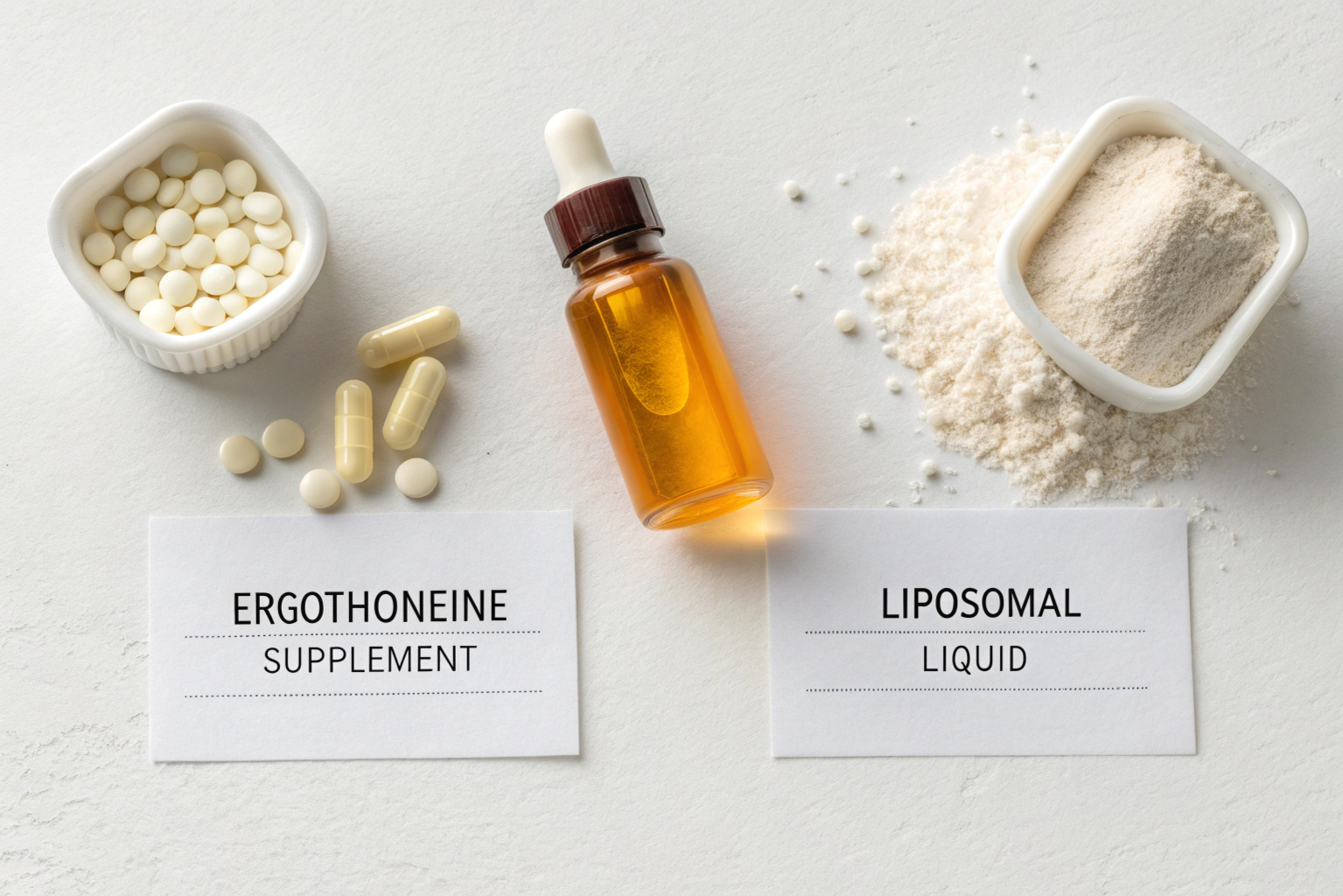
Capsules vs. Powders
| Format | Pros | Cons | Typical Dose |
|---|---|---|---|
| Hard-shell capsule | Easy, travel-friendly | Slower dissolution | 10–20 mg |
| Drink powder | Fast absorption | Taste challenges | 8–15 mg |
| Liposomal liquid | Higher bioavailability | Higher cost, refrigeration | 5–10 mg |
I keep a liposomal shot on hand during overseas flights—just 5 mg quells jet-lag fog because absorption efficiency doubles. For daily convenience, though, capsules win on price and shelf life.
Where Should Ergothioneine Fit Into a Supplement Stack?
A smart stack is like a symphony—each instrument complements the others.
Position ergothioneine alongside mitochondrial cofactors (PQQ, CoQ10) in the morning and collagen or magnesium at night to spread antioxidant support across your circadian rhythm.
Morning:
- 20 mg PQQ
- 10 mg ergothioneine
- 100 mg CoQ10
Evening:
- 10 mg ergothioneine
- Collagen peptides
- 300 mg magnesium glycinate
My Real-World Routine
6 a.m.: Matcha latte + ergothioneine capsule
12 p.m.: Salad heavy on spinach, adds natural l-ergothioneine tracers
6 p.m.: Post-run shake with whey, collagen, and a second 10 mg capsule
This split keeps blood levels steadier than a single megadose and matches the body’s daytime oxidative bursts with fresh antioxidant ammo.
Conclusion
Ergothioneine shines at 10–30 mg daily—listen to your body, adjust for stress, and keep it simple.
-
Learn about the unique dietary practices of mushroom-loving cultures and their health implications. ↩

